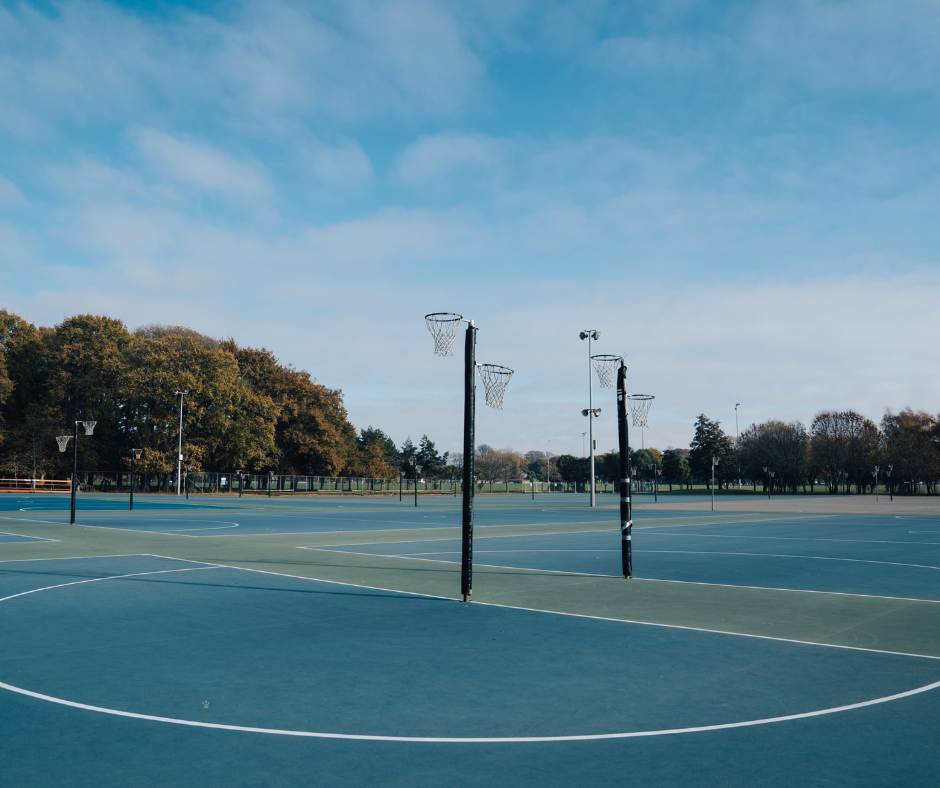Did you know a standard netball court is 30.5 metres long and 15.25 metres wide? That's as big as three tennis courts combined! I find the court's layout fascinating and how it affects the game.
The lines and areas on a netball court are crucial. They guide players and shape strategies. From the centre circle where games start to the goal circles for scoring, each part has its role.
This article from by Sheryl Burns from SBNetball will cover the court's dimensions, the importance of its lines, and key areas like the goal and centre circles. It's great for players and fans alike. Knowing these basics will deepen your understanding of the sport.
The Basics of Netball Court Dimensions
I've always been fascinated by the precise layout of netball courts. It's key for players and fans to know the netball court dimensions. Let's explore the court markings and run-off areas that make this sport stand out.
Court Length and Width
A standard netball court is 30.5 metres long and 15.25 metres wide. This size is ideal for fast-paced action. It lets players move quickly between attack and defence, making the game thrilling for both players and spectators.
Court Divisions: Thirds and Circles
The court is divided into three equal thirds by lines across the middle. At the centre, there's a circle that's 0.9 metres across. Each end has a goal circle, a semi-circle that's 4.9 metres out. These markings tell players where they can move during the game.
The Importance of Run-off Areas
Safety is key in netball, which is why run-off areas are vital. Courts need a 3.05-metre area on side lines and baselines for safety. For outdoor courts, a 1% slope helps with water drainage. Indoor courts stay flat.
| Court Feature | Measurement |
|---|---|
| Court Length | 30.5 metres |
| Court Width | 15.25 metres |
| Centre Circle Diameter | 0.9 metres |
| Goal Circle Radius | 4.9 metres |
| Minimum Run-off Area | 3.05 metres |
Key Lines and Markings on a Netball Court
Knowing the court markings is key for netball players and fans. Let's look at the main lines that shape the game.
Side Lines and Goal Lines
The netball court has clear boundary lines. The long sides are 30.5 metres wide and are called side lines. The short ends, at 15.25 metres, are the goal lines. These lines are 50mm wide and white, making the playing area clear.
Transverse Lines and Centre Circle
Transverse lines split the court into thirds, each 10.17 metres long. At the court's centre is a circle with a 0.9-metre radius. This circle is where the game starts and resumes after goals.
Goal Circles and Their Significance
At each end, the goal circles are found. These semi-circles, with a 4.9-metre radius from the goal line, are where goals are scored. Only certain players can enter these areas, making them key to the game's strategy.
| Court Marking | Dimension | Purpose |
|---|---|---|
| Side Lines | 30.5 metres | Define court length |
| Goal Lines | 15.25 metres | Define court width |
| Transverse Lines | 10.17 metres apart | Divide court into thirds |
| Centre Circle | 0.9-metre radius | Starting point for play |
| Goal Circles | 4.9-metre radius | Scoring area |
Understanding the Netball Court: Lines and Areas
I've always been fascinated by the strategic layout of a netball court. The court is split into three equal sections. Each section plays a key role in the game's flow and tactics.
Goal Thirds: Attack and Defence Zones
The goal thirds are where the action is intense. These areas are for both attack and defence, based on which team has the ball. Players aim to score in the attacking third and block the opposition in the defending third. Each goal third is 10.167m wide, offering players space for strategic moves.
Centre Third: The Neutral Zone
The centre third is a neutral zone and a hotspot for action. All players, except the Goal Shooter and Goal Keeper, can move freely here. It's where the game starts and often ends with a change in possession. This area is vital for switching between attack and defence.
Shooting Circles: Where Points are Scored
The shooting circles, at each end of the court, are where goals can be scored. With a 4.9m radius, these circles are for Goal Attacks and Goal Shooters. It's here that the game's excitement peaks, with each goal worth one point.
| Court Area | Width | Key Function |
|---|---|---|
| Goal Third | 10.167m | Attacking/Defending |
| Centre Third | 10.167m | Transition Play |
| Shooting Circle | 4.9m radius | Scoring |
Player Positions and Court Restrictions
In netball, each player has a special role and area on the court. There are seven positions: Goal Shooter (GS), Goal Attack (GA), Wing Attack (WA), Centre (C), Wing Defence (WD), Goal Defence (GD), and Goal Keeper (GK). These roles are key for both attacking and defending.
The action is in the shooting areas. Only the GS and GA can score goals, and they must be inside the goal circle. The GA can move freely between the centre third and the shooting circle. In defence, the GD and GK work together to stop the opposition from scoring.
The umpires play a big part in keeping the game fair. They move along the sidelines, watching the game closely. Players must wear their position initials 150mm high, visible above the waist, front and back. This makes it easy for umpires and other players to see who's who.
| Position | Court Area | Main Role |
|---|---|---|
| Goal Shooter (GS) | Attacking goal third and circle | Scoring goals |
| Goal Attack (GA) | Centre and attacking thirds | Scoring and feeding the ball |
| Wing Attack (WA) | Centre and attacking thirds | Feeding the ball to shooters |
| Centre (C) | All thirds except circles | Link between attack and defence |
| Wing Defence (WD) | Centre and defending thirds | Marking the WA |
| Goal Defence (GD) | Centre and defending thirds | Defending against GA |
| Goal Keeper (GK) | Defending goal third and circle | Defending against GS |
Knowing these positions and their roles is crucial for players and fans. It's what makes netball exciting to watch and play.
Conclusion
I've looked into the details of netball court dimensions and areas. They are vital for the sport's flow. With 561,000 registered players in Australia and 20 million fans globally, netball's popularity keeps growing.
The court is 30.5m x 15.25m, split into thirds with goal circles. This setup makes for a fast and strategic game. The court's design affects gameplay in big events like the Suncorp Super Netball league.
Netball's rules have changed over time, with updates in 2018. These changes ensure the game is fair and safe. Knowing about the court is key for players and fans to enjoy the game's strategies and tactics.
If you or your child requires netball coaching on the Gold Coast or Brisbane please feel free to reach out to me.


